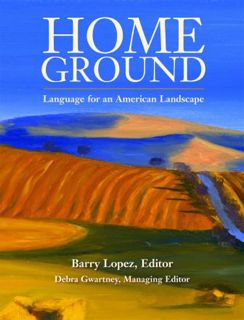The Language of Landscape
Air Date: Week of January 29, 2010

"Home Ground: Language for an American Landscape," edited by Barry Lopez and Debra Gwartney. (Courtesy of Trinity University Press)
Living on Earth continues its series exploring features of the American landscape. It’s based on the book “Home Ground: Language for an American Landscape,” edited by Barry Lopez and Debra Gwartney. In this installment, D. J. Waldie reads his definition of a term apropos for the season – dead ice.
Transcript
YOUNG: It’s Living on Earth, I’m Jeff Young.
[HOME GROUND THEME: Daniel Lanois “O Marie” from Acadie (danielanois.com 2005)]
YOUNG: From time to time, we take the name of our program literally – and consider the nature of the earth we live on, its rocks, ridges and rivers. That’s when we pull out the book “Home Ground: Language for an American Landscape” – with its definitions of terms to describe the soil under our soles and the hills over our heads. Today, D. J. Waldie reads his definition of a term appropriate for the season – dead ice.
WALDIE: Dead Ice. The advance of even a continent-sized ice sheet eventually grinds to a stop. This stalled, slowly melting ice (think of a landlocked iceberg) is said to be dead. Dead Ice has a potent afterlife, however, despite its name.
Large tracts of remnant blocks of ice created the wet, jumbled pothole and hummock landscape of the coteau uplands of North and South Dakota. Debris in the ice and soil deposited on its surface was shed from the melting ice as a semi-frozen gumbo of gravel and earth to form dead ice moraines, where the surface of the dead ice was insulated by a thicker crust of sediment, variations in the melt of the underlying ice allowed the soil to collapse into landscape features as round as a doughnut, a ring of glacial debris, and boggy as a kettle, a sink formed when a core of dead ice surrounded by earth eventually melts. These features collect rain and snowmelt and are favored by migrating waterfowl.
YOUNG: D. J. Waldie is an author, commentator and contributing writer for Los Angeles magazine. His definition of dead ice comes from “Home Ground: Language for an American Landscape”, edited by Barry Lopez and Debra Gwartney.
[MUSIC: Pat Metheny: Entry Point” from Orchestrionn (Nonesuch Records 2010)]
Links
Living on Earth wants to hear from you!
Living on Earth
62 Calef Highway, Suite 212
Lee, NH 03861
Telephone: 617-287-4121
E-mail: comments@loe.org
Newsletter [Click here]
Donate to Living on Earth!
Living on Earth is an independent media program and relies entirely on contributions from listeners and institutions supporting public service. Please donate now to preserve an independent environmental voice.
NewsletterLiving on Earth offers a weekly delivery of the show's rundown to your mailbox. Sign up for our newsletter today!
 Sailors For The Sea: Be the change you want to sea.
Sailors For The Sea: Be the change you want to sea.
 The Grantham Foundation for the Protection of the Environment: Committed to protecting and improving the health of the global environment.
The Grantham Foundation for the Protection of the Environment: Committed to protecting and improving the health of the global environment.
 Contribute to Living on Earth and receive, as our gift to you, an archival print of one of Mark Seth Lender's extraordinary wildlife photographs. Follow the link to see Mark's current collection of photographs.
Contribute to Living on Earth and receive, as our gift to you, an archival print of one of Mark Seth Lender's extraordinary wildlife photographs. Follow the link to see Mark's current collection of photographs.
 Buy a signed copy of Mark Seth Lender's book Smeagull the Seagull & support Living on Earth
Buy a signed copy of Mark Seth Lender's book Smeagull the Seagull & support Living on Earth

